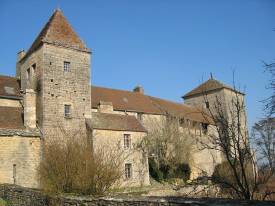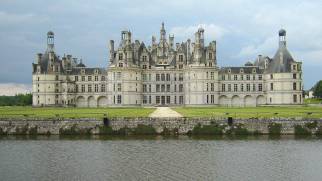Chateaux Tourist Information
 French
châteaux come in all shapes and sizes. The
image most often conjured by the term
'château' is of the Renaissance royal
pleasure-palaces built in the sixteenth
century; Blois, Amboise, Chenonceau in the
Loire valley, and Fontinebleau and
Versailles on the outskirts of Paris. Some
of the Renaissance châteaux of course have a
much older history. Many of the Loire
châteaux are situated at strategic points
along the river, on commanding promontories
or overlooking fords or crossings, and
evidence has been found of much earlier
fortifications, Medieval, Roman and even
Bronze Age. Some Renaissance châteaux retain
part of their earlier heritage, whilst at
others, the sixteenth-century builders got
rid of all that old-fashioned nonsense and
started from scratch.
French
châteaux come in all shapes and sizes. The
image most often conjured by the term
'château' is of the Renaissance royal
pleasure-palaces built in the sixteenth
century; Blois, Amboise, Chenonceau in the
Loire valley, and Fontinebleau and
Versailles on the outskirts of Paris. Some
of the Renaissance châteaux of course have a
much older history. Many of the Loire
châteaux are situated at strategic points
along the river, on commanding promontories
or overlooking fords or crossings, and
evidence has been found of much earlier
fortifications, Medieval, Roman and even
Bronze Age. Some Renaissance châteaux retain
part of their earlier heritage, whilst at
others, the sixteenth-century builders got
rid of all that old-fashioned nonsense and
started from scratch.
Medieval Châteaux
Medieval châteaux in more remote parts of France generally escaped the decorative excesses of the Renaissance. Francis I and Henri II had no interest in travelling all the way to the wild lands of Languedoc or Provence for their refined pleasures. Carcassonne, in the deep South-West remains the most perfectly-preserved example in the world of a medieval fortified city. Until you've been there, you'll look at photos and say, "That can't be real." Sisteron, meanwhile, sits broodingly on its windswept crag in the mountains of Provence, as forbidding as anything you'll find in Wales, the Highlands of Scotland or Transsylvania.
The French are much freer in their application of the term 'château' than we would be about 'castle'. In many small communes, the château can be either the oldest or simply the largest dwelling. There's one in a tiny village near Manosque in Provence, which is actually a copy of the railway station. When the engineer built the railway line in the 1860s, he liked the village so much that he decided to build a house there, and rather than draw up new plans, he used the same plans he'd used for the village station. His new house was, at the time, the largest in the village, so it became 'Le Château'.
Bastide
Then there's
the bastide. The word 'bastide' signifies
something fortified, which can mean anything
from a farmhouse to a small town. Unlike
England, which has been largely war-free
(with a few interruptions) since 1066, you
could reasonably argue that France was in a
state of civil war from the Roman occupation
up to the Paris Commune of 1871. Whilst the kings of France
held nominal sway in Paris, regional Dukes
battled for supremacy in the rest of the
kingdom. Whether you were a Duke, a town
mayor or just a farmer, this called for some
serious fortification. Thus there are
châteaux which are basically high-security
medieval farms. The farmhouse and courtyard
were protected by high stone walls, so that
the livestock could be brought in and the
vast courtyard doors bolted every
night.every night.
Commune of 1871. Whilst the kings of France
held nominal sway in Paris, regional Dukes
battled for supremacy in the rest of the
kingdom. Whether you were a Duke, a town
mayor or just a farmer, this called for some
serious fortification. Thus there are
châteaux which are basically high-security
medieval farms. The farmhouse and courtyard
were protected by high stone walls, so that
the livestock could be brought in and the
vast courtyard doors bolted every
night.every night.
You have to use the word 'château' if you're serious about producing wine. The vineyard house can be relatively modest, what counts is getting the 'château' appellation. I'm not sure how you do that, you'll have to ask. There's also the 'Maison de Maître', roughly equivalent to the English 'Manor House', i.e. the oldest or largest house in the area, i.e. 'château'. In France, a Frenchman's home is his château. Enjoy.